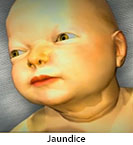
Bilirubin Lights
What is bilirubin?
Bilirubin is a substance that is made as red blood cells break down. Normally the liver removes bilirubin from the blood, but newborn babies’ livers don’t do this well right after birth. When there is a lot of bilirubin, the skin and whites of the eyes get yellow. The yellow color of the skin and eyes is called jaundice.
Low levels of bilirubin are not bad. Rarely, the level of bilirubin can get very high, causing a dangerous condition called kernicterus. Very high levels of bilirubin can be very damaging for a newborn. Early detection and treatment of severe jaundice can lower the level of bilirubin and prevent kernicterus.
What are bilirubin lights?
Bilirubin lights are used to treat newborn jaundice. A certain type of blue light causes bilirubin to change so that the baby’s body can eliminate it in urine or bowel movements. A bilirubin light box shines this blue light onto the skin of a newborn. Baby blankets have also been developed that produce this blue light. As the bilirubin levels decrease, the jaundice gets better.
When are bilirubin lights used?
Your baby will have a blood test or skin test to check the bilirubin level. Bilirubin lights are usually started well before your baby has severe jaundice. Treatments to reduce bilirubin are started before the risk of kernicterus.
What happens during bilirubin light treatment?
Your baby can be treated with bilirubin lights at the hospital. Milder cases of jaundice may be treated at home, but the lights available for use at home are not as strong as the lights available in the hospital.
Your baby will lie on a soft pad under the lights wearing just a diaper. Your baby’s eyes will be covered with goggles or eye patches to protect the eyes from the light. The lights will not hurt your baby's skin.
The amount of time your baby spends under the lights will depend on how high the bilirubin level is and how your baby responds to the treatment. It takes about 4 to 6 hours for the lights to start bringing the bilirubin level down. Some babies are under the lights for a day or less. Others may be under the lights for several days.
Your baby may need more breast milk or formula while under the lights. Some babies need an IV for extra fluid. The extra fluid helps the baby urinate more so that the bilirubin can be removed from the body.
What happens after bilirubin light treatment?
Your baby will need a blood test or a scan of the skin to check the bilirubin level. This test may be repeated several times during treatment.
Follow your healthcare provider's instructions. Ask your child’s provider:
- How long it will take for your child to recover
- How to take care of your child at home
- What symptoms or problems you should watch for and what to do if your child has them
Make sure you know when your child should come back for a checkup.
What are the risks of bilirubin lights?
Bilirubin lights are safe for most babies. However, if porphyria (nerve pain or sensitivity to sunlight) runs in your family, your baby should not receive this treatment. If you have questions about risks and benefits of bilirubin lights, talk with your baby’s healthcare provider.
Last modified: 2016-07-13
Last reviewed: 2016-05-11

